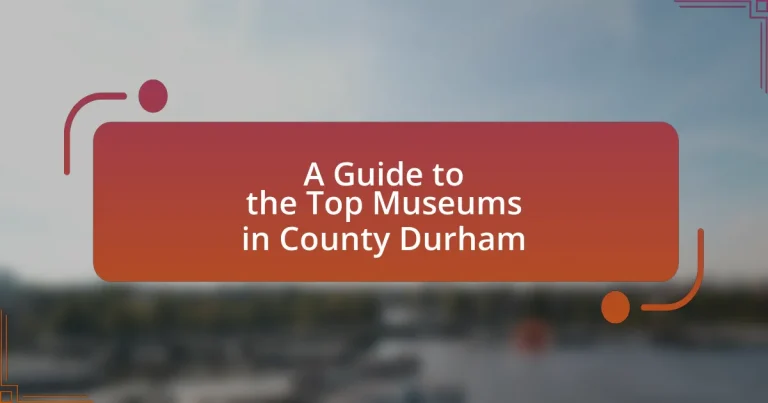The article provides a comprehensive guide to the top museums in County Durham, highlighting key institutions such as the Bowes Museum, the Durham Museum and Heritage Centre, and the Oriental Museum. It discusses the cultural and historical significance of these museums, their contributions to the local community, and the diverse types of exhibits they offer. Additionally, the article outlines visitor information, including opening hours, admission fees, and accessibility options, while also addressing common questions and tips for enhancing the museum experience. Overall, it serves as a valuable resource for anyone interested in exploring the rich cultural landscape of County Durham.

What are the Top Museums in County Durham?
The top museums in County Durham include the Bowes Museum, the Durham Museum and Heritage Centre, and the Oriental Museum. The Bowes Museum, located in Barnard Castle, is renowned for its extensive collection of fine and decorative arts, including works by European masters. The Durham Museum and Heritage Centre focuses on the local history of Durham, showcasing artifacts that highlight the region’s rich heritage. The Oriental Museum, part of Durham University, features collections from Asia, including Chinese ceramics and Indian textiles, making it the only museum in the UK dedicated to the art and archaeology of the East. These museums collectively represent the cultural and historical significance of County Durham.
How do these museums contribute to the cultural landscape of County Durham?
Museums in County Durham significantly enhance the cultural landscape by preserving and showcasing the region’s rich history and heritage. They serve as educational resources, offering exhibitions that highlight local art, industry, and historical events, such as the Durham Cathedral’s role in medieval architecture and the mining heritage of the area. Additionally, these institutions foster community engagement through events and programs that promote local culture, attracting both residents and tourists. For instance, the Bowes Museum features collections that reflect the artistic legacy of the region, while the Durham Museum and Heritage Centre provides insights into the local history, thus reinforcing the cultural identity of County Durham.
What historical significance do these museums hold?
The museums in County Durham hold significant historical value as they preserve and showcase the region’s rich heritage, including its industrial past, cultural evolution, and archaeological findings. For instance, the Bowes Museum features a collection that reflects the artistic and social history of the area, while the Durham Museum and Heritage Centre highlights the local history from prehistoric times to the present. Additionally, the Beamish Museum offers insights into life in the North East during the 19th and early 20th centuries, illustrating the impact of the coal mining industry. These institutions serve as vital resources for education and research, ensuring that the historical narratives of County Durham are maintained and accessible to future generations.
How do these museums engage with the local community?
Museums in County Durham engage with the local community through various initiatives such as educational programs, community events, and collaborative projects. For instance, they often host workshops and lectures that invite local residents to participate in discussions about regional history and culture, fostering a sense of ownership and pride. Additionally, many museums partner with local schools to provide hands-on learning experiences, which not only enhance educational outcomes but also strengthen ties with families in the area. These efforts are supported by statistics showing increased visitor numbers during community events, indicating a positive impact on local engagement.
What types of museums can be found in County Durham?
County Durham features a variety of museums, including art museums, history museums, science museums, and specialized museums. Notable examples include the Bowes Museum, which showcases fine art and decorative arts, and the Durham Museum and Heritage Centre, which focuses on local history. Additionally, the Science Museum in the region highlights scientific advancements and innovations. Each museum offers unique exhibits that reflect the cultural and historical significance of County Durham.
What are the main categories of museums in the region?
The main categories of museums in County Durham include art museums, history museums, science and technology museums, and specialized museums. Art museums in the region showcase local and international artworks, while history museums focus on the cultural and historical heritage of County Durham. Science and technology museums highlight advancements and innovations, and specialized museums may cover niche topics such as mining or local industry. These categories reflect the diverse interests and educational opportunities available to visitors in County Durham.
How do these categories reflect the history and culture of County Durham?
The categories of museums in County Durham reflect its history and culture by showcasing significant local heritage, industrial advancements, and artistic expressions. For instance, the Beamish Museum illustrates the region’s coal mining history and Victorian life, emphasizing the importance of the mining industry to County Durham’s economic and social development. Additionally, the Durham University Oriental Museum highlights the cultural diversity and academic contributions of the area, showcasing artifacts that represent global connections. These museums collectively preserve and interpret the rich tapestry of County Durham’s past, providing insights into its evolution and the values of its communities.
What are the most popular museums to visit in County Durham?
The most popular museums to visit in County Durham include the Bowes Museum, the Durham Museum and Heritage Centre, and the Oriental Museum. The Bowes Museum, located in Barnard Castle, is renowned for its extensive collection of fine and decorative arts, including works by famous artists and a notable collection of 18th-century French porcelain. The Durham Museum and Heritage Centre offers insights into the local history of Durham, showcasing artifacts and exhibitions that reflect the region’s rich heritage. The Oriental Museum, part of Durham University, features a diverse collection of Asian art and antiquities, making it the only museum in the UK dedicated solely to this theme. These museums are frequently visited due to their unique collections and educational value.
What unique exhibits can visitors expect at each museum?
Visitors can expect unique exhibits at each museum in County Durham that highlight the region’s rich history and culture. For example, the Durham Museum features a collection of artifacts from the Roman period, including pottery and tools, showcasing the area’s ancient heritage. The Bowes Museum is renowned for its extensive collection of European fine art and decorative arts, including the famous Bowes Museum Silver Swan automaton, which dates back to the 18th century. The Oriental Museum offers a unique glimpse into Asian cultures with its diverse collection of artifacts, including ancient Chinese ceramics and Japanese prints. Each museum provides a distinct experience that reflects the historical and cultural significance of County Durham.
How do visitor experiences vary among these museums?
Visitor experiences among museums in County Durham vary significantly based on factors such as exhibit diversity, interactivity, and educational offerings. For instance, the Bowes Museum is renowned for its extensive collection of fine and decorative arts, providing a more traditional museum experience focused on visual appreciation. In contrast, the Durham Museum and Heritage Centre emphasizes local history and community engagement, offering interactive displays that encourage visitor participation. Additionally, the Oriental Museum features a unique collection of Asian artifacts, which attracts visitors interested in cultural diversity and global history. These differences in focus and presentation lead to varied visitor experiences, catering to diverse interests and learning styles.
What should visitors know before exploring County Durham’s museums?
Visitors should know that County Durham’s museums often have specific opening hours, admission fees, and may require advance booking for certain exhibits or events. For instance, the Bowes Museum operates from 10 AM to 5 PM and charges an entry fee, while the Durham Museum and Heritage Centre offers free admission but may have limited hours. Additionally, many museums provide educational programs and guided tours, which can enhance the visitor experience. Understanding these details can help visitors plan their trips effectively and make the most of their time exploring the rich cultural heritage of County Durham.
What are the opening hours and admission fees for these museums?
The opening hours and admission fees for the top museums in County Durham vary by location. For example, the Durham Museum and Heritage Centre typically operates from 10 AM to 4 PM, with an admission fee of £5 for adults and £3 for children. The Bowes Museum generally opens from 10 AM to 5 PM, charging £12 for adults and £6 for children. The Oriental Museum usually has hours from 10 AM to 5 PM, with free admission for all visitors. These details reflect the standard operating hours and fees as of 2023.
How can visitors find discounts or special offers for museum entry?
Visitors can find discounts or special offers for museum entry by checking the official websites of the museums, where they often list current promotions. Many museums in County Durham provide discounted tickets for students, seniors, and families, as well as special rates for group visits. Additionally, local tourism websites and social media pages frequently share information about seasonal offers and events that include reduced admission prices. Some museums also participate in national discount programs, such as the National Art Pass, which provides access to multiple venues at a lower cost.
What are the best times to visit to avoid crowds?
The best times to visit museums in County Durham to avoid crowds are during weekdays, particularly Tuesday through Thursday, and during off-peak seasons such as late autumn and winter months. Research indicates that visitor numbers significantly decrease during these times, with many museums reporting up to 30% fewer visitors compared to weekends and summer months. Additionally, early morning hours right after opening tend to have lower foot traffic, making it an ideal time for a quieter experience.
What facilities and services do these museums offer to visitors?
Museums in County Durham offer a variety of facilities and services to enhance visitor experience, including guided tours, educational programs, interactive exhibits, and accessibility options. For instance, many museums provide guided tours led by knowledgeable staff, which help visitors gain deeper insights into the exhibits. Educational programs often cater to schools and families, promoting learning through workshops and activities. Interactive exhibits engage visitors of all ages, allowing them to participate actively in the museum experience. Additionally, accessibility services, such as ramps and audio guides, ensure that all visitors can enjoy the museum regardless of physical limitations. These offerings collectively contribute to a comprehensive and inclusive museum experience in County Durham.
Are there guided tours available at the museums?
Yes, there are guided tours available at the museums in County Durham. Many museums in this region offer structured tours led by knowledgeable guides, enhancing the visitor experience by providing in-depth information about exhibits and historical context. For instance, the Durham Museum and Heritage Centre frequently organizes guided tours that delve into local history and culture, allowing visitors to engage more deeply with the exhibits.
What amenities are provided for families and children?
Museums in County Durham provide various amenities for families and children, including interactive exhibits, family-friendly workshops, and designated play areas. For instance, the Durham Museum and Heritage Centre features hands-on activities that engage children in learning about local history. Additionally, many museums offer family tickets at discounted rates, ensuring affordability for larger groups. Facilities such as baby-changing rooms and child-friendly dining options further enhance the experience for families visiting these cultural sites.
How can visitors enhance their experience at County Durham’s museums?
Visitors can enhance their experience at County Durham’s museums by participating in guided tours and interactive exhibits. Engaging with knowledgeable guides provides deeper insights into the exhibits, while interactive displays allow for hands-on learning, making the experience more memorable. For instance, the Bowes Museum offers guided tours that highlight its extensive art collection, and the Durham Museum and Heritage Centre features interactive displays that showcase local history. These activities not only enrich understanding but also foster a more enjoyable visit.
What tips can help visitors make the most of their museum visits?
To make the most of their museum visits, visitors should plan ahead by researching the museum’s exhibits and events. This preparation allows visitors to prioritize their interests and allocate time effectively, ensuring they do not miss key displays. Additionally, utilizing guided tours can enhance understanding, as knowledgeable guides provide context and insights that enrich the experience. Engaging with interactive exhibits and participating in workshops can also deepen appreciation for the subject matter. According to a study by the American Alliance of Museums, visitors who engage actively with exhibits report higher satisfaction and retention of information.
How can visitors plan their itinerary to include multiple museums?
Visitors can plan their itinerary to include multiple museums by researching museum locations, operating hours, and special exhibits in advance. Utilizing online resources such as museum websites and local tourism boards can provide essential information on proximity and accessibility. For example, County Durham has several museums within a short distance of each other, allowing visitors to create a route that maximizes their time. Additionally, scheduling visits during weekdays or off-peak hours can enhance the experience by reducing crowds.
What resources are available for learning more about exhibits before visiting?
To learn more about exhibits before visiting museums in County Durham, visitors can utilize official museum websites, social media platforms, and online review sites. Official museum websites typically provide detailed information about current and upcoming exhibits, including descriptions, images, and visitor guidelines. Social media platforms, such as Facebook and Instagram, often feature posts and stories that highlight specific exhibits and events, allowing potential visitors to engage with the content visually. Online review sites, like TripAdvisor, offer insights from previous visitors, including their experiences and recommendations regarding specific exhibits. These resources collectively enhance the visitor’s understanding and anticipation of the exhibits they plan to see.
What are some common questions visitors have about County Durham’s museums?
Visitors to County Durham’s museums commonly ask about opening hours, admission fees, and available exhibits. For instance, many inquire whether the museums are open on weekends and holidays, as well as the cost of entry, which can vary by location. Additionally, questions often arise regarding special exhibitions or events, such as guided tours or educational programs, which are frequently highlighted in promotional materials. These inquiries reflect a desire for practical information to enhance their museum experience.
How can visitors prepare for a museum visit in terms of accessibility?
Visitors can prepare for a museum visit in terms of accessibility by researching the museum’s accessibility features in advance. Many museums provide detailed information on their websites regarding wheelchair access, available assistive devices, and accommodations for sensory sensitivities. For example, the accessibility section of a museum’s website may outline the presence of ramps, elevators, and accessible restrooms, ensuring that visitors with mobility challenges can navigate the space comfortably. Additionally, contacting the museum directly can provide personalized assistance and clarify any specific needs or questions regarding accessibility options.
What should visitors know about photography and filming policies in museums?
Visitors should know that photography and filming policies in museums can vary significantly. Many museums allow photography for personal use but prohibit the use of flash, tripods, or professional equipment to protect the artwork and ensure a pleasant experience for all guests. Some institutions may have specific areas where photography is not permitted, often due to copyright restrictions or the sensitivity of the exhibits. For instance, the Bowes Museum in County Durham permits photography in most areas but restricts it in certain exhibitions. Visitors should always check the museum’s official website or inquire at the entrance for detailed guidelines to avoid any violations of policy.




